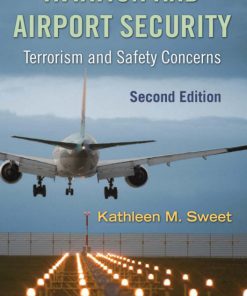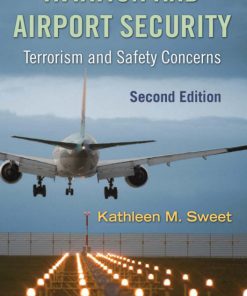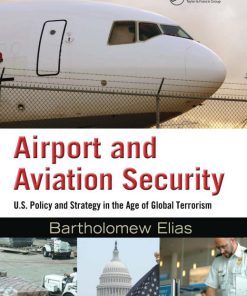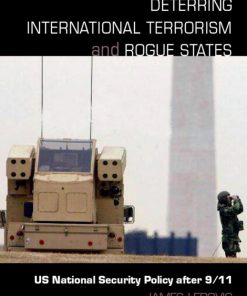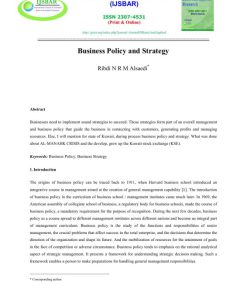Airport and Aviation Security US Policy and Strategy in the Age of Global Terrorism 1st edition by Bartholomew Elias 1040081649 9781040081648
$50.00 Original price was: $50.00.$25.00Current price is: $25.00.
Authors:Bartholomew Elias , Series:Aviation Management [14] , Author sort:Elias, Bartholomew , Languages:Languages:eng , Published:Published:Aug 2009 , Publisher:CRC Press
Airport and Aviation Security US Policy and Strategy in the Age of Global Terrorism 1st edition by Bartholomew Elias – Ebook PDF Instant Download/Delivery.9781040081648,1040081649
Full download Airport and Aviation Security US Policy and Strategy in the Age of Global Terrorism 1st edition after payment
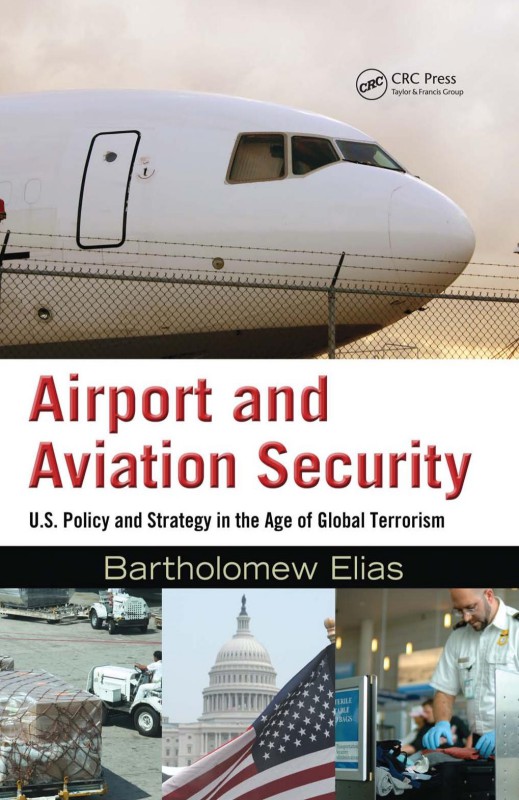
Product details:
ISBN 10:1040081649
ISBN 13:9781040081648
Author:Bartholomew Elias
The response of the U.S. federal government to the events of September 11, 2001 has reflected the challenge of striking a balance between implementing security measures to deter terrorist attacks while at the same time limiting disruption to air commerce. Airport and Aviation Security: U.S. Policy and Strategy in the Age of Global Terrorism is a comprehensive reference that examines the persistent threats to aviation security that led up to the terrorist attacks of September 11th, describes subsequent terror plots against aviation assets, and explores U.S. efforts to counter and mitigate these threats.
Addressing the homeland security challenges facing the U.S. in the age of terrorism, this text explores:
- Security protocol prior to 9/11
- Precursors to 9/11
- The rising threat of Al Qaeda
- Tactical and congressional response to 9/11, including new legislation
- The broader context of risk assessment
- Intelligence gathering
- Airport security, including passenger, baggage, and employee screening
- Airline in-flight security measures
- Airport perimeter security
- The threat of shoulder-fired missiles
- Security for GA (general aviation) operations and airports
Beginning with a historical backdrop describing the dawn of the age of global terrorism in the 1960s and continuing up until the present time, the book demonstrates the broad social and political context underlying recent changes in the aviation security system as a direct result of the 9/11 attacks. Coverage examines ongoing threats and vulnerabilities to the aviation infrastructure, including an exploration of how past terrorist incidents have come to shape U.S. policy and strategy.
Airport and Aviation Security US Policy and Strategy in the Age of Global Terrorism 1st Table of contents:
Chapter 1 Pre-9/11 Threats to Aviation Security and the U.S. Policy Response
The Significance of Aviation Terrorism
The Late 1960s and Early 1970s: The Dawn of the Age of Global Terrorism
Hijackings Tied to Middle Eastern Terrorist Organizations
The Dawson’s Field Hijackings
The U.S. Response to Overseas Terrorist Hijackings
The International Response to Terrorist Hijackings
The Period of Hijacking Contagion
Escalating Violence Prompts FAA Action
The Debate over Passenger Screening
The Debate over Aviation Security Roles and Responsibilities
The Looming Menace of Aircraft Bombings
The 1980s: The Shifting Threat
The TWA Flight 847 Hijacking
Escalating Violence and Terrorist Animosity toward the United States
Aerial Suicides and Airplanes as Missiles
U.S. Initiatives to Improve International Aviation Security
The Escalating Threat of Aircraft Bombings
The Bombing of Pan Am Flight 103
The President’s Commission on Aviation Security and Terrorism.
The Aviation Security Improvements Act of 1990 (P.L. 101-604)
The 1990s: The Failure to Imagine and Adequately Prepare
The Gore Commission Recommendations Regarding Aviation Security
Aviation Security Provisions in the FAA Reauthorization Act of 1996 (P. L. 104-264)
Impact of the Gore Commission on Aviation Security
Lingering Concerns and Persisting Vulnerabilities
The Airport Security and Improvement Act of 2000 (P.L. 106-528)
Hijackings as a Forgotten Threat
References
Chapter 2 The 9/11 Attacks and the Ensuing Policy Debate
Precursors to 9/11
Bojinka Plot
Rising Threat of Al Qaeda
Buildup to 9/11
Preattack Phase: Terrorists in our Midst
9/11 Attacks
Tactical Response on September 11, 2001
DOT Rapid Response Teams
Conclusions and Recommendations of the Airport Security Rapid Response Team
Conclusions and Recommendations of the Aircraft Security Rapid Response Team
Congressional Response to the 9/11 Attacks
Expanding the Federal Role in Aviation Security Operations
Post-9/11 Debate over Federalizing Passenger Screening
Aviation and Transportation Security Act (ATSA, P.L. 107-71)
Homeland Security Act of 2002 (P.L. 107-296)
Vision 100: The Century of Aviation Reauthorization Act (P.L. 108-176)
References
Chapter 3 Policy Refinement in Response to the Evolving Terrorist Threat
The 9/11 Commission and Its Impact on Aviation Security Policy
Aviation Security-Related Recommendations of the 9/11 Commission
Enhancing Passenger Prescreening
Improving Measures to Detect Explosives on Passengers
Addressing Human Factor Considerations at Screening Checkpoints
Expediting Deployment of In-Line Baggage Screening Systems
Intensifying Efforts to Identify, Screen, and Track Cargo
Deploying Hardened Cargo Containers
Risk-Based Prioritization as the Basis for Transportation Security Policy
National Intelligence Reform and Terrorism Prevention Act of 2004 (P.L. 108-458)
TSA Regulations to Strengthen Air Cargo and the Push for 100% Cargo Screening
Lingering Congressional Policy Concerns
Implementing Recommendations of the 9/11 Commission Act of 2007 (P.L. 110-53)
Continuing Terrorist Threat
Post-9/11 Anthrax Attacks
Attempted Shoe Bombing of American Airlines Flight 63
Al Qaeda’s Post-9/11 Ambitions
Evolving Terror Threat
The UK Airplanes Bombing Plot
Homegrown Terrorist Threats in the United States
An Asymmetric Threat Intent on Diminishing Our Resolve
Cost of Protecting Aviation
References
Chapter 4 The U.S. Strategy for Combatting Terror Threats to the Aviation Domain
Pre-9/11 Approaches to Aviation Security
Post-9/11 Actions Addressing Aviation Security Policy and Strategy
The National Aviation Security Policy
Security Threats to Aviation
Aircraft-Related Threats
Threats to Aviation Infrastructure
Threats Involving Exploitation of Air Cargo
The Risk-Based Framework
Strategic Objectives
Strategic Actions
Maximizing Domain Awareness
Deploying Layered Security
Promoting a Safe, Efficient, and Secure Aviation System
Fostering International Cooperation
Assuring Continuity of Operations
Strategic Roles and Responsibilities
Aviation Mode-Specific Plans
Aviation Transportation System Security Plan
Guiding Principles
Goals and Requirements
The Air Domain Surveillance and Intelligence Integration Plan
Guiding Principles
Considerations and Assumptions
The International Outreach and International Aviation Threat Reduction Plans
The Aviation Operational Threat Response Plan
Guiding Principles
Considerations and Assumptions
Concept of Operations
The Domestic Outreach Plan
Issues for Consideration
The Validity of Underlying Risk Assumptions
Consideration of System Sustainability
A Proactive or a Reactive Approach?
Consideration of Whether the Strategy Is Comprehensive and Robust
Alignment of Strategic Objectives with Budgetary Planning and Resource Allocation Processes
References
Chapter 5 Evaluating and Managing Security Risks
Risk Assessment Methods
Using the Risk-Based Framework to Determine a Risk Valuation and Assess Costs and Benefits
Approaches for Developing Complex Models of Risk in the Aviation Security Domain
Mitigating Aviation Security Risk
The Multilayered Approach to Aviation Security
Evaluating the Effectiveness of Mitigation Measures and Security Systems
Applying SDT to Evaluating the Performance of Aviation Security Systems
Detection Criteria and System Errors
System Sensitivity
Assessing the Impact of Security Measures on Air Transportation System Efficiency
Mitigating the Consequences of an Attack
Adaptive Systems Approaches to Aviation Security
References
Chapter 6 Exploiting Intelligence and Counterterrorism Information
An Overview of Intelligence Gathering and Analysis
Intelligence Reforms in Response to the Global Terror Threat
TSA’s Role in Transportation Security Intelligence
Tracking Terrorist Travel in the Aviation Mode
Airline Passenger Prescreening and Terrorist Watch Lists
Pre-9/11 Passenger Prescreening Initiatives
Computer-Assisted Passenger Prescreening System
“No-Fly” and “Automatic Selectee” Lists
The CAPPS II Development Effort
Secure Flight System Development
Operational Implementation of Secure Flight Terrorist Watch List Checks
Prescreening of International Passengers
Risk-Based Targeting of International Air Travelers and Shipments
Immigration Controls at International Airports of Entry
Prescreening of Aviation Workers and General Aviation Passengers
Policy Issues Related to Passenger Prescreening and Terrorist Watch List Checks
Accuracy and Reliability of Underlying Terrorist Databases
False Positive Matches and Potential Failures to Detect Terrorist Threats
Passenger Redress Procedures
Future Directions for Exploiting Intelligence Information to Strengthen Aviation Security
Using Intelligence Information to Identify Terrorist Networks
Data Fusion in the Aviation Environment
Data Logic and Current Data Fusion Practices
Parametric Data Fusion Networks
Ongoing Initiatives for Improving Data Fusion Practices
References
Chapter 7 Passenger and Baggage Screening
Policy Considerations for Aviation Security Screening
Airline Passenger Traffic Growth
Screening Efficiency and Passenger Wait Times
Space Constraints at Airports
Improving Explosives Detection at Passenger Checkpoints
In-Line EDS Integration
Strategic Planning for Addressing Technology and Human Factors Needs
Projected Costs and Funding Issues
Checkpoint Screening Human Performance
Potential Impacts of Respecting Privacy on Screening Performance
Covert Testing
Threat Image Projection
X-Ray Imagery and Carry-On Baggage Screening Performance
Passenger Checkpoint Efficiency
Passenger Wait Times
Potential Security Risks of Checkpoint Inefficiencies
Queuing Practices and Procedures
The Tailored Self-Select Screening Lane Initiative
The RT Program
Options for Further Streamlining Passenger Checkpoint Procedures
Checkpoint Procedures for Liquids
Passenger Education and Informational Materials
The Evolution of Checkpoint Design
Next Generation Checkpoint Technologies
ETD Technologies
ETD Machines
Bottle and Liquid Explosives Scanners
Walk-Through ETD Portals
WBI Technologies
X-Ray Backscatter Imaging Systems
Millimeter Wave Imaging Systems
AT X-Ray Equipment
Other Candidate Technologies and Applications for Aviation Security Screening
Screening Airport Workers
Screening and Vetting of Airline Crews
Checked Baggage Screening
Proposed Strategy for Baggage Screening Optimization
Options for Reducing Baggage
Firearms in Checked Baggage
Screener Workforce Issues
Broadening Roles for TSOs
Screener Retention
Screener Hiring Standards
TSA Staffing Needs
Salaries, Benefits, and Career Advancement Initiatives
Reducing Workplace Injuries
Whistleblower Protections
References
Chapter 8 Airline In-Flight Security Measures
Hardened Cockpit Doors
Secondary Flight Deck Barriers
Flight Deck Access Procedures
Video Surveillance of the Airliner Cabin and Improved Cabin–Cockpit Communications
Uninterruptable Aircraft Transponders
Future Systems for Aircraft Surveillance
The Federal Air Marshal Service
Post-9/11 Air Marshal Hiring and Training
Controversies Regarding Air Marshal Force Size and Flight Coverage
Air Marshal Operational and Procedural Issues
Armed Pilots and Crew Security Training
Legislative Background
FFDO Program Implementation Issues
Issues Regarding Operational Procedures for Armed Pilots
Special Considerations for FFDOs
Consideration of Less-Than-Lethal Weapons for In-Flight Security
Security Training for Airline Crews
Armed Law Enforcement on Airliners
Historical Context
Federal, State, and Local LEOs Flying Armed
Identity Verification Procedures for Armed LEOs
Handling Disruptive Passengers and Other In-Flight Security Incidents
Possible Terrorist Probing Incidents
Responding to In-Flight Security Threats
Mitigating the In-Flight Explosives Threat and Improving Aircraft Survivability
In-Flight Chemical and Biological Threats
References
Chapter 9 Commercial Airport Access Controls and Perimeter Security
Security Risk in the Airport Environment
Commercial Airport Security Program Concepts
Airport Security Technology Investment
Airport Security Programs
Airport Security Terminology
Security Designations within the Passenger Terminal
Security Identification Display Areas
Security of Designated GA Areas
Security of Military Facilities at Commercial Passenger Airports
Security of the AOA
The Airport Perimeter
Airport Contractor and Vendor Security Programs
Airport Security Risk Categories
Evaluating Airport Compliance with Security Requirements
Airport Physical Security and Security Technologies
Airport Perimeter Security and Access Control Measures
Surveillance Technologies
Infrared Sensors and Thermal Imaging Cameras
Computer Vision Technologies
Ground Surveillance Radar
Ground Vehicle Tracking
Sensor Integration
Patrolling the Airfield and the Airport Perimeter
Security Awareness Training
Law Enforcement Support
Explosives Detection Canine Teams
Law Enforcement Reimbursable Agreements
Access Control Measures
Background Check Requirements
Transportation Security Clearinghouse
Security Threat Assessments
Regulations Pertaining to Airport Badges and Identification Systems
Biometric Technologies for Credentialing and Access Controls
Planning, Design, and Construction Guidelines for Commercial Airport Security
Landside Security Considerations
Crime Prevention Strategies
Countermeasures for Chemical and Biological Threats
Detecting Radiological and Nuclear Threats in the Airport Environment
Critical Incident Management and Response
References
Chapter 10 Mitigating the Threat of Shoulder-Fired Missiles and Other Standoff Weapons
The Proliferation of Shoulder-Fired Weapons and the Terrorist Threat They Pose
IR-Guided MANPADS
CLOS MANPADS
Laser Beam Rider MANPADS
Terrorist Acquisition and Possession of MANPADS
Other Standoff Weapons
The Vulnerability of Commercial Airliners
The Vulnerability of Typical Commercial Flight Operations
The Survivability of Civilian Transport Aircraft
Civilian Aviation Encounters with Shoulder-Fired Missiles
Assessing the Potential Consequences of a Standoff Attack
U.S. Policy and Strategic Approaches
Nonproliferation and Weapons Reduction Initiatives
Counterterrorism Strategies and Tactics
Airport Security Measures
Flight Operational Procedures
Aircraft-Based Protections and Countermeasures
Homeland Security Counter-MANPADS Systems Development and Testing
Policy Considerations for Aircraft-Based Countermeasures Deployment
Unmanned Escorts Providing IR-Countermeasure Protection
Ground-Based Countermeasures
References
Chapter 11 Air Cargo Security
Security Risks Posed by Air Cargo
Explosives and Incendiary Devices
Hazardous Materials
Cargo Crime
Aircraft Hijacking and Sabotage
Airmail Consignments
Screening versus Physical Inspection of Cargo Shipments
Security in the All-Cargo Environment
Arming All-Cargo Pilots
Cargo Inspection Methods and Technologies
Known Shipper Approach
Physical Screening and Inspection
Canine Explosives Detection Teams
Cargo Screening Technology
X-Ray Screening
Explosive Detection Systems
Chemical Trace Detection Systems
Neutron Beam Technologies
Millimeter Wave Imaging Systems
Cost of Cargo Screening and Inspection
Potential Impacts on Passenger Airlines and Freight Forwarders
Potential Impacts on Manufacturers and Other Shippers
Hardened Blast-Resistant Cargo Containers
Technologies for Effectively Securing the Supply Chain
Tamper-Evident and Tamper-Resistant Seals
Access Control and Biometric Screening Technology
Physical Security of Air Cargo Facilities
Inspection and Oversight of Air Cargo Facilities
Security Training for Air Cargo Personnel
Increased Control over Access to Aircraft and Cargo Facilities
References
Chapter 12 Security for GA Operations and Airports
What Is GA?
GA Flight Operations
GA Aircraft
GA Airports
The Economic Impact of GA
The Security Challenge Posed by GA
Security Vulnerabilities
The Terrorist Threat
Potential Consequences of an Attack Using GA Aircraft
Suicide Attacks and Conventional Explosives
Chemical, Biological, Radiological, and Nuclear Threats
Nuclear Power Facilities as Potential Targets
The Risk Picture for GA Aircraft
Options for Mitigating GA Security Risks
Security Risk Assessments
Surveillance and Monitoring
The Airport Watch Program
Applying Behavioral Pattern Recognition Techniques in the GA Environment
Airport Access Controls
Background Checks and Vetting
Vetting of Individuals Seeking Flight Training
Checking FAA Records on Pilots and Others against Criminal and Terrorist Databases
Background Check Requirements for Charter Operators
Vetting of Charter and Aircraft Lease Customers
Tracking Aircraft Sales
Physical Security Measures for Airports
Physical Security Measures for Aircraft
Securing Agricultural Aviation Operations
Flight School Security
Security Practices for Business and Charter Aviation
The TSA Access Certificate Program
Security Measures for Charter Operations
Security Measures for Large Private and Corporate Aircraft
Vetting and Tracking GA Flights at the U.S. Borders
Airspace Restrictions
Airspace Restrictions around Washington, DC
The Flight Restricted Zone
GA Access to DCA
The Maryland Three Airports
The Washington, DC, ADIZ
Security-Related Flight Restrictions throughout the United States
Airspace Restrictions for Presidential Visits
Policy Issues Regarding Airspace Restrictions
Effective Surveillance and Monitoring of Restricted Airspace
Curbing Airspace Violations
Airspace Protection and Homeland Defense
People also search for :
business aircraft use policy
us customs and border protection air interdiction agent pilot
us airport security
cybersecurity and aviation
airport and aircraft security



